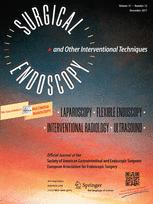Wendling MR, Melvin WS, Perry KA
Surg Endosc. 2013 Oct;27(10):3754-61.
BACKGROUND:
Gastroesophageal reflux disease (GERD) remains a significant problem for the medical community. Many endoluminal treatments for GERD have been developed with little success. Currently, transoral incisionless fundoplication (TIF) attempts to recreate a surgical fundoplication through placement of full-thickness polypropylene H-fasteners. This, the most recent procedure to gain FDA approval, has shown some promise in the early data. However, questions of its safety profile, efficacy, and durability remain.
METHODS:
The Cochrane Library and MEDLINE through PubMed were searched to identify published studies reporting on subjective and objective GERD indices after TIF. The search was limited to human studies published in English from 2006 up to March 2012. Data collected included GERD-HRQL and RSI scores, PPI discontinuation and patient satisfaction rates, pH study metrics, complications, and treatment failures. Statistical analysis was performed with weighted t tests.
RESULTS:
Titles and abstracts of 214 papers were initially reviewed. Fifteen studies were found to be eligible, reporting on over 550 procedures. Both GERD-HRQL scores (21.9 vs. 5.9, p < 0.0001) and RSI scores (24.5 vs. 5.4, p ≤ 0.0001) were significantly reduced after TIF. Overall patient satisfaction was 72 %. The overall rate of PPI discontinuation was 67 % across all studies, with a mean follow-up of 8.3 months. pH metrics were not consistently normalized. The major complication rate was 3.2 % and the failure rate was 7.2 % across all studies.
CONCLUSION:
TIF appears to provide symptomatic relief with reasonable levels of patient satisfaction at short-term follow-up. A well-designed prospective clinical trial is needed to assess the effectiveness and durability of TIF as well as to identify the patient population that will benefit from this procedure.
Link to abstract on PubMed: Wendling, et al; Surg Endosc. 2013 Oct;27(10):3754-61.


